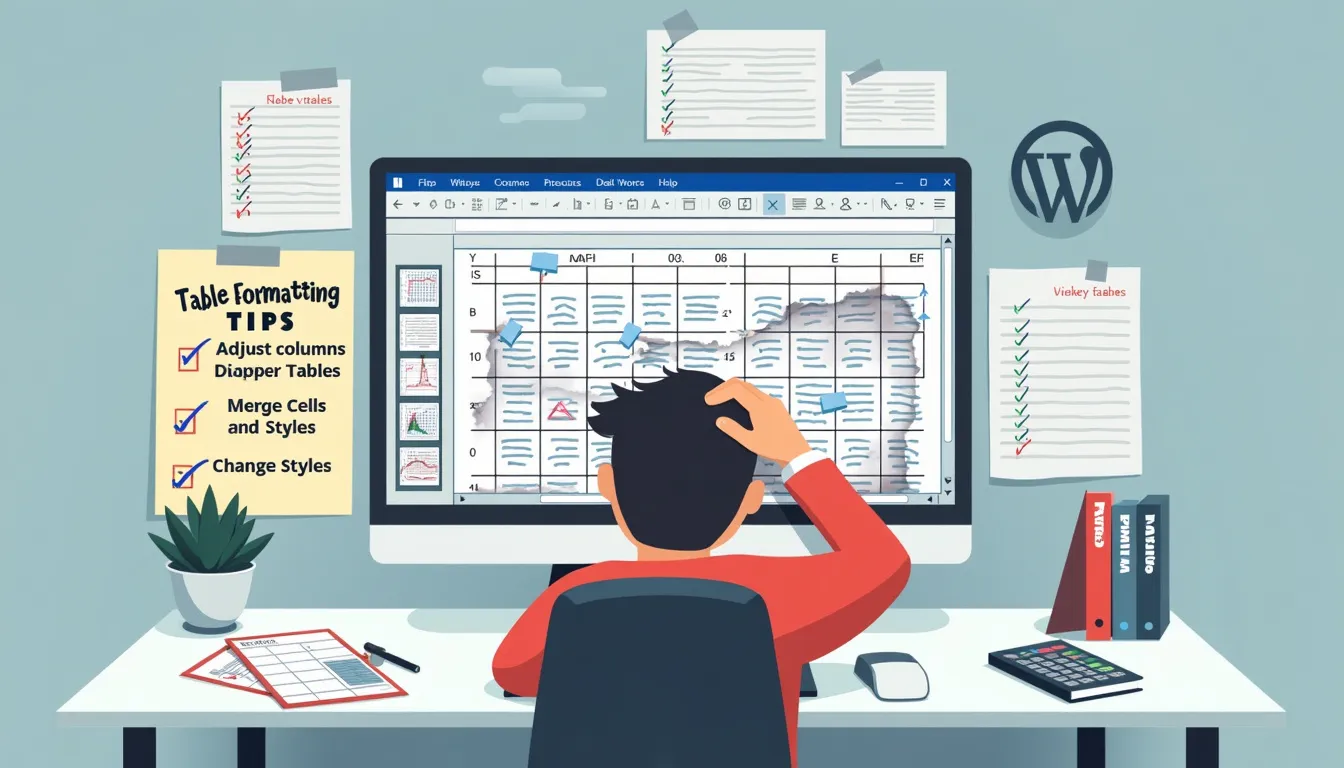Last Updated: September 15, 2024
Are you tired of juggling with messy tables in Microsoft Word? It can feel like trying to wrestle a greased pig! Fear not, because you’re not alone. Many users face the same daunting challenge when it comes to troubleshooting Microsoft Word table formatting. Whether it’s misaligned columns, stubborn cell borders, or text that seems to have a mind of its own, these formatting dilemmas can be frustrating. We’ll peel back the layers of confusion and walk you through simple steps to restore order to your tables.
In this article, we’ll first dive into the most common table formatting problems in Word, so you can easily identify what’s going wrong. Then, we’ll arm you with effective, step-by-step solutions to get your tables looking sharp in no time. From adjusting properties to utilizing design tools, we’ve got all the tricks up our sleeves. Let’s get started, and soon you’ll have perfectly formatted tables that make even the most meticulous office manager proud!
Table Of Contents
Understanding Common Table Formatting Problems in Microsoft Word
1.1. Identifying Issues: Misaligned Columns and Rows
Have you ever printed a document only to discover that your neatly arranged table looks like it went through a whirlwind? Misaligned columns and rows can be a real headache when troubleshooting Microsoft Word table formatting. Here are some common culprits:
- Invisible Gaps: Sometimes, columns look misaligned due to invisible spaces or extra formatting characters.
- Inconsistent Widths: Different width settings for columns can lead to a visually unappealing table.
- Row Heights: If row heights vary, the table can look messy and unstructured.
To identify these issues, zoom in on your table, and take a good look at each column and row. You might even want to use the Gridlines option to make them stand out!
1.2. Recognizing Problems with Cell Borders and Shading
Next up in the troubleshooting Microsoft Word table formatting saga: cell borders and shading. Have you noticed that the borders of your table seem to have a mind of their own? Here are some issues you might encounter:
- Inconsistent Borders: One cell might have a solid line while another sports a dotted line, causing confusion.
- Shading Misalignment: Cell shading can also play tricks on your eyes, making it hard to focus on the content.
- Border Color: Sometimes, a faint border color might make your table difficult to read!
Check your settings under the Table Design tab to ensure consistency across your table.
1.3. Troubleshooting Microsoft Word Table Formatting Errors Related to Text Wrapping and Alignment
Ah, the enigmatic world of text wrapping and alignment! If text inside your table cells behaves like a rebellious teenager, it might be time for some troubleshooting. Here’s what to keep an eye on:
- Text Wrapping: Check if the text is set to wrap in a way that meets your needs. Text can sometimes overflow beyond its cell, creating a chaotic effect.
- Vertical and Horizontal Alignment: Misalignment can ruin the aesthetics of your table. Always set text to align centrally, left, or right as per your preference — consistency is key!
- Font Size and Style: A huge font in a narrow column is the bane of table formatting. Be cautious with your choices!
Adjust these settings by going to the Table Properties and selecting Cell Options. Pro tip: Keep a consistent font across your document for a polished look!
With these common issues identified, you’re one step closer to becoming a master of troubleshooting Microsoft Word table formatting. Keep your eyes peeled for hidden formatting flaws, and you’ll turn your tables from scrambled messes back into organized masterpieces!
As you delve deeper into troubleshooting Microsoft Word table formatting, try different combinations of adjustments until you find the perfect fit for your document. Happy troubleshooting!
Step-by-Step Solutions for Resolving Table Formatting Issues
So, your Microsoft Word tables are causing a ruckus? Fret not! Let’s dive into some easy-to-follow steps for troubleshooting Microsoft Word table formatting issues like a pro.

2.1 Adjusting Table Properties: Width, Height, and Cell Margins
First things first, let’s get into the nitty-gritty of table properties. Adjusting width, height, and cell margins can make a world of difference. Here’s how:
- Select Your Table: Click anywhere inside the table you wish to modify.
- Access Table Properties: Right-click on the table and select Table Properties from the context menu.
- Width and Height: In the table properties window, go to the Row and Column tabs.
- Adjust the preferred width of columns to ensure they line up neatly.
- Set the height for rows to keep text within the desired amount of space.
- Cell Margins: Click on the Cell tab to adjust margins. Adequate cell margins can help with readability and aesthetics.
By following these simple steps, you’ll be on your way to a perfectly formatted table!
2.2 Using the Table Tools Design and Layout Tabs Effectively
This feature is a treasure trove for troubleshooting Microsoft Word table formatting woes. Let’s see how you can maximize the Table Tools Design and Layout tabs:
| Tab | Function |
|---|---|
| Design | Choose styles, colors, and shading for your table. Spicing up the design can also highlight key parts of the data! |
| Layout | Adjust the positioning of your table within the document, merge cells for easier navigation, and align text inside cells for clarity. |
Here’s a quick tip: If you want your table to sing, don’t skip out on the design options! A well-styled table can enhance the reader’s experience and focus.
2.3 Implementing Quick Fixes for Common Formatting Glitches
A table formatting glitch in Microsoft Word can make you feel like you’re on a roller coaster! Fortunately, there are quick fixes to set things right. Here are some rapid-fire solutions:
- Table Reset: Simply select the table and go to the Layout tab. Click on convert to text and then convert back to table. It’s like a quick reboot!
- Clearing Formatting: Highlight the problem area and press Ctrl + Space to clear extra formatting. Sometimes, less is more!
- Use Styles: Leverage Microsoft Word’s built-in styles. Navigate to the Design tab and select a style that suits your table. This can sometimes solve multiple issues at once!
- Compress Columns: If columns are wider than necessary, select them and use your mouse to drag them closer together or use the properties to adjust width.
These quick fixes are your best friends when it comes to troubleshooting pesky Microsoft Word table formatting glitches!
Next time you find yourself tangled in a world of table troubles, remember to try these strategies. With a little patience and a pinch of adjustment, you can turn your chaotic tables into structured wonders. Happy formatting!
For more tricks and tips, be sure to check out Microsoft’s official blog for insightful resources!
Or, for a deeper dive into table styles and formatting, visit Word’s help documentation. You’ll find tons of valuable information that can take you from table rookie to table wizard!
Conclusion
Troubleshooting Microsoft Word table formatting doesn’t have to be a daunting task. By understanding the common issues, such as misaligned rows, problematic cell borders, and text wrapping challenges, you can swiftly address any formatting hiccups.
The step-by-step solutions provided give you a robust toolkit for adjusting table properties, using the Table Tools tabs effectively, and applying quick fixes. Remember, practice makes perfect, and the more time you spend navigating these solutions, the more efficient you’ll become. Embrace the art of table troubleshooting and create polished, professional documents that shine. With patience and the strategies outlined, you’ll soon be managing Microsoft Word tables like a pro—one cell at a time!





